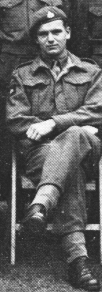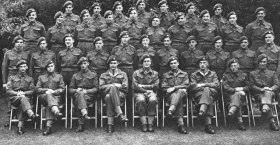Douglas Galbraith was born in Glasgow, Scotland, on the 23 December 1921.
As part of his education he qualified on a course in industrial administration.
He initially served in the ranks for 2 years and 67 days before being given an emergency commission as a Second Lieutenant in the Reconnaissance Corps, 25 July 1942.
Douglas was posted immediately to the 1st Air Landing Squadron, Reconnaissance Corps and allocated to ‘A’ Troop. He went with the Squadron to North Africa and Italy, May – November 1943.
He was awarded a Mention In Despatches on the 24 August 1944 for his actions in the Italian Campaign.
In the attack on MOTTOLA, this Officer led a party of eight men, armed with Brens and Stens in a flanking attack on a ridge, strongly held by the enemy. Despite very strong light automatic and mortar fire, this small party pressed on to its objective and succeeded in dislodging an enemy force considerably stronger numerically and in weight of fire-power. This success was very largely due to the personal leadership and complete disregard of danger displayed by this Officer.
He carried out a parachute course in North Africa, August 1943. Douglas then commanded No 2 Section of ‘A’ Troop, 1st Airborne Reconnaissance Squadron in the Battle of Arnhem.
He was put forward for an award of the Distinguished Service Order, but awarded the Military Cross instead, for his actions at Arnhem. It was announced in the London Gazette on the 9 November 1944.
“The above mentioned officer at ARNHEM took over command of "A" Troop 1st Airborne Recce Squadron on the night of 21 September 1944, his Troop Commander having been wounded. The task of the Troop was to hold a line of houses on the north of the perimeter. His troop were continuously attacked by infantry and self-propelled guns, but the position was still held. On 25th September 1944 one of his sections was forced to withdraw owing to the intense bombardment Lieutenant Galbraith rallied his Troop and led them into an assault to retake the house. Amidst intense mortar fire and severe sniping, Lieutenant Galbraith rushed up to the house throwing 30 grenades on the windows. The house was retaken and held. Throughout the whole of the action at Arnhem, Lieutenant Galbraith was outstanding in leadership and maintenance of his objective.”
On the 24 September, Panzer Grenadiers had infiltrated the right flank of "A" Troop and fired a panzerfaust at one of the walls of their buildings, bringing injury and confusion to those inside. Lance-Corporal Ken Hope recalled, "...I remember gazing around wildly, the Bren muzzle describing the frenetic 180-degree arc, and wondering from which direction opponents in field grey would suddenly appear... The concussion {from the panzerfaust} was quite catastrophic. "Where the bloody hell do you think you are all going? Now just bloody well settle down!" There was no mistaking the Scots accent of Lieutenant Galbraith. The command was compelling, imperious, demanding instant obedience. The effect was instantaneous, a text-book exercise in disciplined response to sustained military training. Control was immediately restored, the panic instantly dissipated; everyone was alert, ready to react."
‘Remember Arnhem’. By John Fairley.
Whilst the Squadron was back in England, resting and refitting, Douglas married Sheena Griffiths on the 10 January 1945. They had three children, Douglas 26/10/57. Jean 14/09/58 and David 05/09/59.
In June 1945 ‘Dougie’ Galbraith returned to the U.K. from Norway and transferred to the 6th Airborne Armoured Reconnaissance Regiment in July 1945, where he served as the Second In Command of C-Troop.
He is mentioned in three books.
‘I Bought a Star’, by Thomas Firbank. NOTE: The author fictionalised his characters and Lieut. Douglas Galbraith is referred to as Lt. Dougal.
‘Remember Arnhem’, by John Fairley.
‘Freddie Gough’s Specials at Arnhem, by Robert Hilton.
SERVICE HISTORY.
01.10.1947. Transferred, The Cameronians (Scottish Rifles) [short service commission]
03.06.1950. Transferred, Royal Army Ordnance Corps [permanent commission]
WS/Lt. 25.01.1943
A/Capt. 27.09.1944-26.12.1944
T/Capt. 27.12.1944-22.12.1948
A/Maj. 16.03.1947-09.04.1947, 27.05.1947-14.06.1947
Lt. 01.10.1947, seniority 25.01.1943 [short service commission]
Capt. 23.12.1948
Lt. 03.06.1950, seniority 23.06.1944 [permanent commission]
Capt. 03.06.1950, seniority 23.12.1948
T/Maj. 03.08.1954-22.12.1955
Maj. 23.12.1955
T/Lt. Col. 02.02.1963-13.06.1963
Lt. Col. 14.06.1963 (retd 07.04.1972)
‘Dougie’ Galbraith died in Leeton, NSW, Australia in June 1975.
OBITUARY. From the Pegasus Journal, October 1975, page 17.
“Lt-Col D. Galbraith MC
Dougie Galbraith joined 1st Airborne Reconnaissance Squadron in July 1942 and served
with Airborne Forces until 1947. He was Mentioned in Dispatches in the operations around Taranto in September 1943 and earned his MC at Arnhem. Too old for a regular commission in the infantry after the war he transferred to RAOC and retired in April 1972.
Dougie was an outstanding young officer and greatly loved by his men.
He leaves a widow and three children.”
CFHG. [Colonel. C.F.H. Gough, MC, TD.]
Created with information and images kindly supplied by R Hilton
Read More


Latest Comments
There are currently no comments for this content.
Add Comment
In order to add comments you must be registered with ParaData.
If you are currently a ParaData member please login.
If you are not currently a ParaData member but wish to get involved please register.